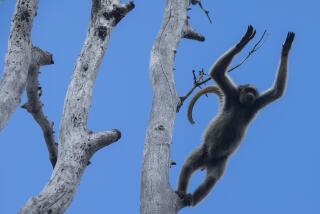Cameras Focus on Elusive Rhino : Wildlife: The reputed source of Marco Polo’s unicorn finds refuge in Indonesian reserve.
- Share via
UJUNG KULON, Indonesia — The jungle-clad western tip of Java shelters the rarest of rhinoceroses, the reputed source of Marco Polo’s unicorn and survivor of one of the biggest explosions in history.
The one-horned Javan rhino, once found from Bangladesh to Indonesia, is the breed of rhinoceros most threatened with extinction. Only two, maybe three, of its jungle homes are left.
A handful live in Vietnam, and footprints of the wrinkly, leather-skinned animal were found this year on the Indonesian island of Sumatra.
Most of the 70 or so thought to remain live in the rich, lowland forests and glinting white beaches of Ujung Kulon.
The reserve is one of the most important in Indonesia, a huge tropical archipelago that is home to one of the world’s richest collections of plants, animals and insects.
“On the beach you see more rhino footprints than humans’ ” prints, shouted former geologist Mike Griffiths over the roar of the sea, which edges the reserve that man and nature have defended from the rest of the thickly populated island of Java.
Griffiths, a field officer with the Worldwide Fund for Nature, and his team have sliced their way through the jungle to plant 40 cameras with flash-guns around the reserve. They photograph anything weighing more than 33 pounds that steps on a nearby pressure pad.
Griffiths, a New Zealander, defended the high cost of the technique that he developed, saying it is the surest and quickest way to find out just how many rhinos there are.
The alternatives are counting footprints and droppings or just waiting for one to come by.
He estimated that it would take four years to do the same work by taking casts of the footprints--it is the middle toe of the hind foot that really sets the rhinos apart.
On a recent visit the only trace of a rhino was a smear of mud that one had left on a tree some weeks earlier as it squeezed through the forest.
The rhinos, reputedly mistaken for the mythical unicorn by Italian explorer Marco Polo on his travels 700 years ago, have a reputation for being fierce.
Team members grinned as Griffiths related how one member recently leaped into the jungle’s thorniest tree--the snake fruit--to escape the Javan rhino’s plow-like charge.
“I’ve never seen such fear,” he said.
Ujung Kulon’s great attraction for rhinos, apart from being the sort of lowland forest they like, is that the government makes sure that nobody lives in the 74,000-acre park.
The initial deterrent came about a century ago when nearby Krakatau mountain blew to pieces in the biggest volcanic explosion in recorded history.
The eruption--30 times the size of the biggest H-bomb explosion--triggered a huge tidal wave that swept through the area, killing more than 36,000 people.
By the time rice farmers started to filter back earlier this century, the Dutch colonial government had already decided to turn the area into a reserve. They used tales of tigers and malaria to scare off would-be residents.
The tigers have long gone, but the forests bustle with other wildlife.
About half of the birds of Java can be found in the park, among them bright green peacocks, hornbills, with their distinctive bright bills, eagles and jungle fowl--ancestor to the village chicken.
There are leopards--October is the mating season--wild cattle, crocodiles, snakes, monkeys and the hairy-nosed otter, which, according to Griffiths, might be even rarer than the rhino.
So why the fuss over the rhino, without which the forest could quite well survive? Why not, for example, the termite that is probably more important to the local ecological system?
“If you save the rhino, you save everything else in the park,” Griffiths said, explaining that the rhino is a flagship species.
The rhino is being taken as the mascot to provide the focus the Indonesian government needs to protect the reserve.
The animal is at the center of a debate over whether to protect it in its natural habitat or haul it off to zoos to try captive breeding.
Defenders of in situ conservation say the park is well protected and zoos have no proven track record for breeding rhinos, who can be choosy about their mates.
It would need about half the estimated rhino population to even try to breed them in captivity. Then the offspring must be taken back to the wild.
“I think you’d have a hell of a problem introducing rhinos back into Ujung Kulon,” said Griffiths.
“If you’re born and bred in the rain forest, you’d be fairly hardened and smartened to it by the time you’re an adult. But if you introduce a zoo-bred animal, it’s like sending innocents to the slaughterhouse.”
More to Read
Sign up for Essential California
The most important California stories and recommendations in your inbox every morning.
You may occasionally receive promotional content from the Los Angeles Times.













